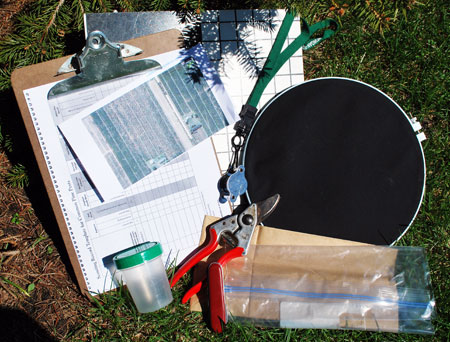Considerations for pesticide use and selection this season for growing Christmas trees
Christmas tree growers should consider the potential negative impacts of excessive or inadequate use of pesticides and utilize IPM strategies to minimize risks.
Integrated pest management (IPM) provides a number of methods for mitigating risks associated with pesticide use and pest management. As the 2013 season approaches, Michigan State University Extension recommends growers prepare for a robust scouting program that includes identifying pests, knowing beneficial predators when they see them, minimizing pesticide application, rotating pesticide modes of action to prevent resistance, and making the sometimes tough call to cull infested trees.

Basic scouting tools.
Minimizing pesticides applications is not a new strategy for growers, but is an important means of helping cut costs and protect valuable beneficial insects like natural enemies. Incorporating the critical IPM practice of scouting can provide you with the confidence to decide not to apply a pesticide application based on current conditions and can also help determine the ideal timing to maximize the efficacy of your pesticide application, potentially reducing the number of applications needed to achieve economic control of the target pest. It is also important to be patient and not preemptively retreat an area. Many pesticides, particularly the newer chemistries, may take a week or more to finally control the pest. Of course, this is just another reason to be sure you fully understand the mode of action you are applying (is it lethal, sublethal, anti-egglaying or antifeedant) and its longevity in the field.
As systems-driven research continues to grow, the evidence is clear that naturally occurring predators and biological controls that occur naturally in the environment play an important role in balancing pest populations. As this season approaches, consider the natural enemies of your pest insects that might provide your farm with some much needed help in controlling the population. Consider that many of the pesticides we have available can be hard on natural enemies. Treat only when you have to and, if possible, choose products that are the least harmful to predators. Visit the Biocontrol page at MSU’s Integrated Pest Management Program web site for more information on identifying common natural enemies.
Remember to rotate pesticide mode of action to slow the development of pesticide resistance. Over time repeated applications of the same pesticide mode of action can select for pests that are resistant to the material. These resistant individuals are then able to procreate, becoming a larger proportion of the population over time until the pesticide is rendered useless. This phenomenon occurs in pests and diseases and is an inevitability for the new single-site pesticides hitting the market in recent years and even occurs in older, broad-spectrum pesticides, albeit more slowly. To help slow the development of resistance, don’t use the same pesticide or class (modes of action) of pesticides year-after-year.
In the Christmas tree Insecticide and Miticide table, we have indicated the IRAC code. This code indicates the class of pesticide and can also be found on the pesticide label. Pesticide classes differentiate between modes of action and should help you rotate materials correctly. With insecticides in Christmas tree production, it is best to rotate products each application.
Lastly, as the season approaches, be prepared to make those tough decisions and cull, cull, cull. In the field we often see hot spots for insect or disease with initial infestation on a few trees. A couple of textbook examples include pine tortoise scale or spruce gall midge. Removing these infested trees from the plantation helps mitigate the risk to the plantation by eliminating a big source of insect or disease pressure and will help with your overall control program, potentially minimizing the amount of pesticides necessary in a given field.
In the coming season, utilizing all available IPM control strategies will be the best way to minimize risk and weigh the economic and environmental sustainability of a given management decision.



 Print
Print Email
Email

